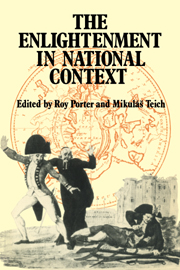Book contents
- Frontmatter
- Contents
- Preface
- 1 The Enlightenment in England
- 2 The Scottish Enlightenment
- 3 The Enlightenment in France
- 4 The Enlightenment in the Netherlands
- 5 The Enlightenment in Switzerland
- 6 The Italian Enlightenment
- 7 The Protestant Enlightenment in Germany
- 8 The Enlightenment in Catholic Germany
- 9 Reform Catholicism and Political Radicalism in the Austrian Enlightenment
- 10 Bohemia: From Darkness into Light
- 11 The Enlightenment in Sweden
- 12 The Russian Enlightenment
- 13 Enlightenment and the Politics of American Nature
- Afterword
- Notes to the text
- Further reading
- Index
10 - Bohemia: From Darkness into Light
Published online by Cambridge University Press: 24 September 2009
- Frontmatter
- Contents
- Preface
- 1 The Enlightenment in England
- 2 The Scottish Enlightenment
- 3 The Enlightenment in France
- 4 The Enlightenment in the Netherlands
- 5 The Enlightenment in Switzerland
- 6 The Italian Enlightenment
- 7 The Protestant Enlightenment in Germany
- 8 The Enlightenment in Catholic Germany
- 9 Reform Catholicism and Political Radicalism in the Austrian Enlightenment
- 10 Bohemia: From Darkness into Light
- 11 The Enlightenment in Sweden
- 12 The Russian Enlightenment
- 13 Enlightenment and the Politics of American Nature
- Afterword
- Notes to the text
- Further reading
- Index
Summary
Unexpectedly, I found the scholars in this place much disposed towards the Enlightenment and, in part, to possess good brains as well.
G. Forster to S.Th. Sömmering from Prague on 26 July 1784, in H. Hettner (ed.), Georg Forsters Briefwechsel mit S. Th. Sömmering (Braunschweig, 1877), p. 102.
In order to understand the Enlightenment in Bohemia in proper historical perspective it is necessary to go back to the Thirty Years’ War started by the uprising of the Bohemian estates. This was set in motion by the renowned Defenestration at the Prague Castle when the Emperor's representatives (together with their secretary) were thrown out of the window of the council chamber on 23 May 1618.
The defeat of the rebel armies in the Battle of the White Mountain near Prague on 8 November 1620 had far-reaching effects. The Habsburgs consolidated their constitutional position in Bohemia, set up through the union of Bohemia, Hungary and their hereditary Austrian dominions after the Battle of Mohács in 1526. By radically curtailing the powers of the Bohemian Diet and by declaring the Habsburg right to be hereditary kings of Bohemia without election, Ferdinand II (1618–37) paved the way for the establishment of Habsburg absolutism in Central Europe. The balance of influence within the Bohemian estates was also changed. The Catholic clergy, in the back seat since the Hussite struggles, regained its lost standing and took precedence over the other three estates: lords, knights and towns. The latter were restricted to the casting of one vote.
- Type
- Chapter
- Information
- The Enlightenment in National Context , pp. 141 - 163Publisher: Cambridge University PressPrint publication year: 1981
- 2
- Cited by

